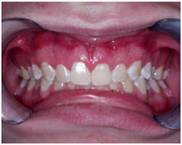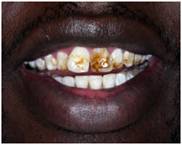Overview
Dental cleanings involve removing plaque (soft, sticky, bacteria infested film) and tartar (calculus) deposits that have built up on the teeth over time. Your teeth are continually bathed in saliva which contains calcium and other substances which help strengthen and protect the teeth. While this is a good thing, it also means that we tend to get a build-up of calcium deposits on the teeth. This chalky substance will eventually build up over time, like limescale in a pipe or kettle. Usually it is tooth coloured and can easily be mistaken as part of the teeth, but it also can vary from brown to black in colour.
If the scale, or calculus (tartar, as dentists like to call it) is allowed to accumulate on the teeth it will unfortunately provide the right conditions for bacteria to thrive next to the gums. The purpose of the cleaning and polishing is basically to leave the surfaces of the teeth clean and smooth so that bacteria are unable to stick to them and you have a better chance of keeping the teeth clean during your regular home care.
The professional cleaning of teeth is sometimes referred to as prophylaxis (or prophy for short). It's a Greek word which means "to prevent beforehand" - in this case, it helps prevent gum disease.
How Are Dental Cleanings Done ?
The dental hygienist or dentist uses specialized instruments to gently remove these deposits without harming the teeth. The instruments which may be used during your cleaning, and what they feel like, are described below.
Ultrasonic Instrument
Commonly used first is an ultrasonic instrument which uses tickling vibrations to knock larger pieces of tartar loose. It also sprays a cooling mist of water while it works to wash away debris and keep the area at a proper temperature. The device typically emits a humming or high pitched whistling sound. This may seem louder than it actually is because the sound may get amplified inside your head, just like when you put an electric toothbrush into your mouth.
The ultrasonic instrument tips are curved and rounded and are always kept in motion around the teeth. They are by no means sharp since their purpose is to knock tartar loose and not to cut into the teeth. It is best to inform the operator if the sensations are too strong or ticklish so that they can adjust the setting appropriately on the device or modify the pressure applied.
Polishing
Once all the surfaces are smooth, the dental worker may polish your teeth. Polishing is done using a slow speed handpiece with a soft rubber cup that spins on the end. Prophylaxis (short for prophy) paste - a special gritty toothpaste-like material - is scooped up like ice cream into the cup and spun around on the teeth to make them shiny smooth.


Fluoride
Your dentist may also apply fluoride. Fluoride foam or gel is then placed into small, flexible foam trays and placed over the teeth for 30 seconds. Afterwards the patient is directed to spit as much out as possible into a saliva ejector. The fluoride helps to strengthen the teeth since the acids from bacteria in dental tartar and plaque will have weakened the surfaces.
It is best not to eat, drink or rinse for 30 minutes after the fluoride has been applied Fluoride is known to strengthen teeth and is an element that occurs in nature. By strengthening the teeth, fluoride is effective in lowering the incidence of decay in teeth. Several sources of fluoride are available to the public, and experts recommend using a variety of sources. Water naturally contains fluoride in very small quantities.
Several foods and beverages naturally contain fluoride, for example eggs, fish, meat, and tea. Many communities have added fluoride to their drinking water, and the majority of toothpastes, mouth rinses, and treatments in the dental office contain fluoride. Fluoride tablets are available with a prescription for children who do not live in areas where fluoridated drinking water is available.
Fluoride Enters The Mouth And Directly Enters Tooth Enamel. This Occurs In Several Ways : -
- During dental office fluoride treatments
- During teeth brushing with fluoride toothpastes or using fluoride rinses
- During fluoridated water drinking
In-office fluoride treatments are regularly used during a child's regular check-up, every six months. However, if children are at higher risk of dental decay, they will require extra fluoride. These fluoride treatments help to support tooth remineralisation. The in-office and/or supplemental fluoride serve as additional defence against dental decay, even with the consumption of water that is fluoridated.
In children over 6 years old, who have a history of cavities, mouth rinses containing fluoride can help. They are available over-the-counter. The dentist may also prescribe fluoride gels and rinses that contain increased levels of fluoride in certain cases.
Fluoride supplements are generally prescribed by a dentist or a paediatrician to the 6-16 year old category of patients who have no access to fluoridated drinking water. Either tablets or liquids are available, depending on the age of the patient.
Both primary and adult teeth can be helped with fluoride. Basically, anybody at risk for developing tooth decay should receive fluoride treatments.
The following reasons should be considered when evaluating whether additional fluoride should be used with a patient : -
- Not visiting the dentist regularly
- Unsatisfactory oral hygiene habits
- Snacking frequently, especially on sugar-containing snacks.
Several medications can cause dry mouth (i.e., xerostomia), including medications used of hypertension, allergies, depression and anxiety. Xerostomia worsens the decay process.
Warning For Children Using Fluoride Toothpaste
Children can swallow some of the toothpaste when brushing. If too much fluoride is ingested during the development of the adult teeth, then the enamel may be discolored. Fluorosis usually happens during a child's first few years when the teeth are forming. Ingestion of excess fluoride during the first seven years of the child can permanently disco lour the incisor teeth. Most cases ar, however, mild. You should teach your child to avoid swallowing toothpaste and spit out it.
- Under seven years of age : - Parents should supervise the child when brushing. A child should not be allowed to suck toothpaste from the tube. Use toothpastes especially formulated for children.
- Under 2 years age : - Do not use any toothpaste when brushing the teeth of children under two years of age.
- 2 years age : - Use only a pea-sized (5mm) amount of fluoride toothpaste.
- Over seven years of age : - Can use toothpastes used for adults without any supervision.
The Hazards Of Fluoride
There is no doubt that the use of fluoride decreases dental caries. But it is also a fact that the ingestion of too much fluoride can result in fluorosis. You should know the associated hazards of fluoride. Fluoride is an acute toxin. You should monitor your child if he is using a fluoride toothpaste, because, you do not know how much of the toothpaste your child is swallowing. Half a tube of fluoride toothpaste can kill a child.
For more information, medical assessment and medical quote
as email attachment to
Email : - info@wecareindia.com
Contact Center Tel. (+91) 9029304141 (10 am. To 8 pm. IST)
(Only for international patients seeking treatment in India)










